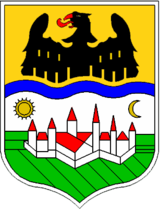Project: Donauschwaben
Categories: German Projects | Austro-Hungarian Empire | Donauschwaben | German Roots Project
Donauschwaben Germany is a sub project of the Germany project.
There is a campanion Free-Space Project page which covers some of the same territory Banater Schwaben
The Donauschwaben, or Danube Swabians, are German-speaking people who settled in and around the Danube River in southeastern and central Europe in several waves through the 18th and 19th centuries.
The Austro-Hungarian Empire, having taken much of the area back from the Ottoman Empire, actively recruited subjects to colonize the neglected lands and make them arable and profitable, and not incidentally, to defend them against Ottoman raids.
It's estimated that around one million ethnic Germans lived in these regions before WWII.

|
The [1]Donauschwaben or Danube Swabians is a term for the German-speaking population who lived in various countries of southeastern Europe, mainly the Danube River valley. Most were descended from 18th-century immigrants recruited as colonists to repopulate the area.
Language
The Danube Swabian language is a mixture of many dialects of the original German settlers, mainly Swabian, Franconian, Bavarian, Rhinelandic/Pfälzisch, Alsatian, and Alemannic, as well as Austro-Hungarian administrative and military jargon. Other influences include Serbian and Croatian, Russian, Romanian, Turkish, English, Balkan and South Slavic loanwords like Kukuruts.

|
Coat of Arms
- A black eagle representing the protection of the Emperor of Austria
- A blue ribbon representing the Danube River
- A crescent moon representing the waning of Islamic influence through the withdrawal of the Ottoman Turks
- The Sun representing both Prince Eugene of Savoy and the light of Christianity; and
- A fortress representing the fortified city of Temeschburg.
Notable Banat Swabians
- Geza von Cziffra, film director
- Helmuth Duckadam, football goalkeeper, winner of European Cup and current record holder for most penalty kicks saved in a shootout.
- Werner Fricker, President, United States Soccer Federation 1986–1990
- Franz Xaver Kappus (1883–1966), writer, poet, newspaper editor
- Stefan Jäger, painter
- Nikolaus Lenau, writer
- Herta Müller, poet, novelist and recipient of the 2009 Nobel Prize in Literature
- Anthony N. Michel, American engineering educator
- Johnny Weissmuller (born Johann Weißmüller), American actor; Olympic swimming gold medalist
- Michael J. Wendl, American engineer
- Stefan Hell, co-recipient of the 2014 Nobel Prize in Chemistry
- Zita Johann, Austrian-American actress (The Mummy)

|
| Donasuschwaben im Karpatenbecken |
Contents |
How to Participate 
If you would like to be involved in the Donauschwaben Team, please join the Germany Project and let them know you're interested in the Donauschwaben team.
- Project Members:
- Jacqueline Clark
- Michael Kargl
- Susanne Kube
- Maggie N (familiar with the Hungarian parts of Donauschwaben)
- Florian Straub
Project Mission and Tasks at WikiTree
The main mission of the Donauschwaben Roots Project is to spot Donauschwaben profiles and develope them on WikiTree.
- Identify ancestors with Donauschwaben roots.
- Add sources to Donauschwaben profiles.
- Place regional category on your Donauschwaben ancestor. If your village or town has not been created yet, ask Maggie or the categorization leader, Steven Harris, to make one for you.
- Copy and paste the following template on profiles that have German ancestry.
- {{German Roots Sticker}}
- {{German Roots Sticker}}
All about Banater and the Donauschwaban Territories
Donauschwaben [1]
Regions with significant populations
- Hungary - 131,951
- Romania - 13,510
- Serbia - 4,064
- Croatia - 2,965
Languages
- Hungarian, Romanian, Serbian, Croatian, German
Religion
- Roman Catholicism, Lutheran
Related ethnic groups
- Germans of Hungary
- Germans of Romania
- Germans of Serbia
- Germans of Croatia
- Banat Swabians
- Satu Mare Swabians
Resources
For more information, see:
- Burgenland Villages in Hungarian, German & Croatian
- Wikipedia: Danube Swabians
- The Danube Swabian Resource Site
- Donauschwaben Villages Helping Hand
- Danube- Swabians.org
- Maps county index - Danube Swanbian Maps
- DVHH.org - Danube Swabian History
- Genealogientz.de - History of the Danube Swabians
- Donauschwaben Cleveland.com - Donauschwaben History
- Trenton Donauschwaben.com - Trenton Donauschwaben Association
- Donauschwaben-USA.org - History Donauschwaben in den USA
- Family Search - Banat Genealogy
- Genealogienetz.de - History of German settlements in southern Hungry
- DVHH.org - Donasuschwaben Villiages helping hands
- Youtube - Original Donauschwaben. "In der Banater Heide"
- Working Group of Donauschwäbischer Familienforscher -AKDFF
- The Donauschwaben
- Death Book of the Donauschwaben
- Family History Series Book VI-BANATERS IN AUSTRIAN MILITARY RECORDS
- Books of the Banat
- Villages Helping Hands (DVHH) Facebook page
- Banat village list DVHH has the most complete list of villages in Banat, there are about 800.
- Banaterscom - History of German Settlements in Southern Hungary
- Blackseagr.org - Researching Germans from Hungary
- Danube Swabians.org - Danube Swabian Resources
- Maps Josephine Austrian procured lands 1763-1787
- Genealogy RO Group Genealogical Research in the Banat Area
This page was last modified 12:34, 12 June 2024. This page has been accessed 2,685 times.